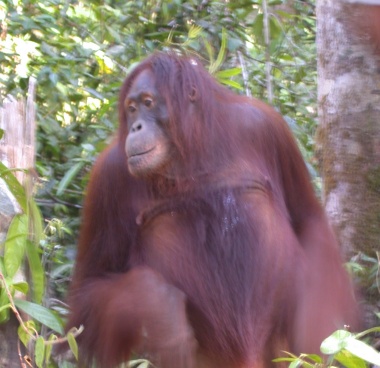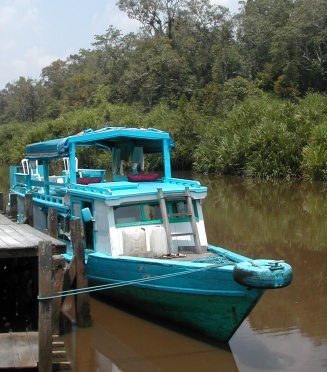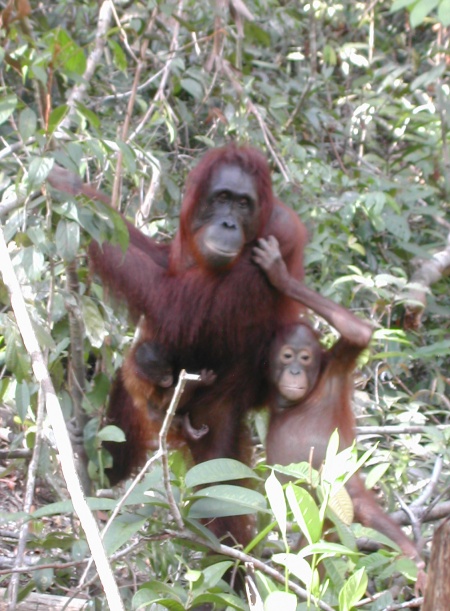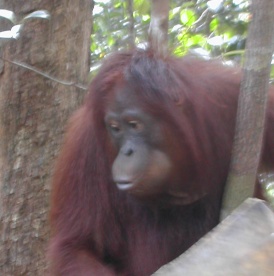KALIMANTAN
Our sail from the north shore of Bali to Kalimantan was 410 miles. We chose to do it in two legs. The first leg was 210 miles from Bali to Bawean, and the second leg was 200 miles from Bawean to Kalimantan.
The first leg was a lousy sail – if we can even call it a sail. We motored 25.7 out of 33.3 hours – or more than 75% of the time. We probably could have sailed during the night with the jib poled out, but we usually don’t rig the pole at night because it pretty much guarantees that someone will have to go on the foredeck during the night, and we try to avoid that. So we motorsailed. Nonetheless, we did stay busy through the night. There were many fishing boats and ships, and we had to do a bit of dodging and weaving. But our boring trip ended in a calm quiet bay on Bawean where we tidied up the boat and got a good night’s sleep before heading off on our second leg.
The second leg from Bawean to Kalimantan was completely different from the first leg. It was somewhat bumpy and boisterous, but it was a raucous good time. We made such good time that we decided to continue 12 miles up the river to Kumai. We were anchored in Kumai by 3:00 pm local time.
Borneo is the world’s third-largest island. The majority of the island belongs to Indonesia and is called Kalimantan. A considerable piece belongs to Malaysia, and the tiny country of Brunei is on the northwest coast. Kalimantan is the reality behind the myths about mist-shrouded rainforest and headhunting indigenous people. It is also still one of only two homes of wild orangutans which is why we went there. We anchored Passage in Kumai which was our ‘base’ while we headed off on some river/land travel
We went to Kumai to see the orangutans, but our trip became much more than a day of sightseeing. We wanted to learn about the orangutans, and we knew that that included learning a bit about their environment, so we planned a five-day-four-night trip in to the Tanjung Puting National Park where efforts are ongoing to save the orangutan and its tropical rain forest.
In the 1930s, the colonial Dutch government created two wildlife reserves – totaling more than 750,000 acres – on the south coast of Borneo. Those areas were combined in the 1970s to form the Tanjung Puting Wildlife Reserve, and they became Tanjung Puting National Park in 1981. In 1996, the park’s size was increased to its present size of more than one million acres. As a national park, it is protected under national law.
Tanjung Puting became known to the outside world in the 1970s when a Canadian anthropologist, Birute Galdikas, came to study the orangutans. Her work was twice featured on the cover of National Geographic magazine, and the world became aware of Borneo’s orangutans. Studying and protecting the orangutans became Galdikas’s life’s work, and she continues to direct the Orangutan Foundation International (www.orangutan.org) which works to protect the orangutan and its environment.

Today the park is one of the world’s largest protected tropical rain forests, and it is rich in biodiversity. Its flora includes more than 600 types of trees and 200 varieties of orchid. Its fauna includes almost 250 species of birds, 28 species of large mammal (including nine species of primate), and a significant population of orangutans – estimated at around 3,000.
The park, however, is seriously threatened by palm oil plantations, illegal logging, mining, irrigated farming, and fire. The greatest threats are from palm oil plantations and illegal logging. If the rain forest is lost, the orangutan will follow.

We slept on the top deck under a tarp
Orangutans
The name ‘orangutan’ was created from the Malay words ‘orang’ (person) and ‘hutan’ (forest). Orangutan means ‘person of the forest’.
Orangutans once lived throughout Asia, but there are now only two species, and they are on only two islands – Sumatra and Borneo. These populations probably numbered around 300,000 a century ago, but their numbers have recently plummeted. Estimates made in 2004 placed 50,000 orangutans on Borneo and only 7,000 on Sumatra.
The primary cause of these markedly decreased numbers is loss of habitat. More than 80% of Borneo’s orangutan habitat has been damaged or lost in the last 20 years.
The orangutan is the only great ape in Asia. They share 96.4% of their DNA with humans, and along with other great apes, they are man’s closest living relative.
The orangutan has many physical similarities to man and a few marked differences. Obvious similarities include their forward-facing eyes, small ears, and teeth. Obvious differences include the length of their arms which are longer than their legs. Also, their feet resemble their hands (both large), and their hips are highly articulated. The adult male may weigh more than 250 pounds, but the adult female weighs on average only 100 pounds.
Orangutans are the largest arboreal animals in the world. They are, in fact, dependent on trees for survival. They spend approximately 60% of their time foraging for food in the canopy and 40% sleeping and resting.
Females are sexually mature between 12 and 15 years of age. They have singleton births after an eight-month pregnancy. Young orangutans remain largely dependent on their mothers until 3 to 4 years of age, and then they gradually develop their independence by 6 or 7 years of age. Females usually give birth only every six to eight years, so they will likely produce only three or four offspring in their lifetime. Orangutans are thought to live into their 40s in the wild.
The orangutans in the park (approximately 3,000) are of two primary groups –the wild and the rehabilitated. Wild orangutans are just that – wild. However, the park is also home to hundreds of orangutans that have been rescued and rehabilitated to live in the wild. Many of these orangutans return to ‘feeding stations’ where they are given a small daily supplement of bananas, pineapple, and sometimes milk. These orangutans forage for their food, but they also enjoy the special treats given at the feeding stations. Most visitors to the park see these rehabilitated orangutans.
We traveled the rivers in the park in a local style of boat called a klotok. These boats are approximately 39’ long and 6 ½’ wide with a draft of 3’. Their hulls are built of ironwood, and the upper structures are of various local hardwoods. Although they have two levels of deck, each deck is less than 4’high. Walking about is limited to a few small open areas. They are powered by small single cylinder diesel engines, and only a few have any muffler. We were told they were named ‘klotok’ because of the noise they make.
Our boat had a crew of four. Suma was our captain, and his mate was Masrun. Our cook – and a very good cook, indeed – was Darmin, and our guide was Arsyad. We were the only two passengers on this trip.
Day 1 – We motored 20 minutes down the Kumai River to the entrance to the Sekonyer River. The Sekonyer was a muddy brown, and the banks were lined with Nipa Palms which many locals use for roofs on their houses. We went another 90 minutes up the Sekonyer to our first stop – Tanjung Harapan.
After an excellent lunch, we went on a hike through rain forest for about an hour. We saw a few maroon leaf monkeys – supposedly relatively uncommon – swinging around the canopy top. It was very hot and humid, and we were not acclimating very quickly. Sweat was pouring off us.

Black water Sekonyer Kanan River
Then we went to our first feeding station. A platform about 12’ square was built 4’ off the ground and a pile of bananas was in the center of it. We stood 15 to 20’ away. A large male quickly came in and ate at least five pounds of bananas. As he wandered off and climbed up a tree, a few females – most with offspring – came in to eat. We watched eight or ten of them come and go for about an hour, then we returned to the boat.
We slowly cruised further up the river to see the proboscis monkeys in the trees along the river. These are very odd looking creatures. The females have long pointed noses that curve upward, but the homely males have large bulbous noses that hang down over their faces. They also make a somewhat obnoxious nasal sound. Nothing cute about these monkeys.
We also saw many long-tailed macaques – the monkeys we saw on Rinca and Bali. These were numerous along the river shore.
We spent the night tied to a small dock at Ponkok Tanggui. We did not go ashore.

Princess and her two offspring. Her baby is only 14 days old.
Day 2 – We awoke to the magical sounds of the gibbons singing, and we headed further upriver over breakfast. We had a two hour trip to Camp Leaky. Along the way we saw many proboscis monkeys, storks, hornbills, and our favorites – kingfishers.
Camp Leaky is up the Sekonyer Kanan which is a narrow tributary of the Sekonyer River. The water of the Kanan is clear and black. It looks like very dark tea. Camp Leaky was an incredible experience – one that we will never forget. We started by visiting their Info Center which was very well done. Then we went on a two hour hike through rain forest. We came across only one wild male that we were told is ‘very dangerous’, so we gave him lots of room. We visited Camp Wilkie which is where Dr. Galdikas started her research in 1971, and we saw a few rehabilitated orangutans as we returned closer to Camp Leaky.
After lunch we went to a feeding, and it was the highlight of the day (actually of our entire trip!). There was a moderately large male that dominated the activities, but it was interesting to see how others responded to him. There were countless moms and babies, and a few of them were remarkably comfortable around people.
Our favorite was Princess. She is an 18 year old rehabilitated orangutan who is very comfortable around people. She has two closely-spaced offspring with her, and her youngest baby was only 14 days old. We never got within arm’s reach, but she was otherwise easily approachable. She seemed to enjoy the contact.
We also got within arm’s reach of Kusasi – the former dominant male of this area. Kusasi is a massive animal, and it is easy to imagine him as the ferocious dominant force he once was. However, Kusasi is now 33 years old, and the younger (22 years old) Tom has taken over as dominant male. Apparently this change of power involved some vicious fighting. Kusasi appears to be an aged defeated soul.
We could have easily spent a few days at Camp Leaky. An amazing place!
But daylight was fading, so we returned to the boat and motored a few miles down river to Croc Lake. We again listened to noisy proboscis monkeys as the day ended.
Day 3 – We again awoke to the sound of gibbons (unfortunately these guys start singing at sunrise – before 5:00 am). We traveled down the Sekonyer Kanan toward Pondok Tanggui – where we spent our first night. As we went, our guide spotted a stork, monitor lizard, and two crocs. He was a very good spotter.
We went to a feeding shortly after arriving at Pondok Tanggui. It was a good experience, but everything seemed to pale in comparison to our experiences the previous day at Camp Leaky.
After the feeding, we left on our planned trek through the rain forest. We were initially told that this would be a four mile hike. That morning we were told that it would be a twelve mile hike. Sure, we could have backed out, but we wanted the experience, so we forged ahead.

The heat and humidity defy description. This is, after all, rain forest less than three degrees off the equator. At times it was difficult to keep going, but we had no alternatives. We trudged through swamp and bog; we crawled over and under fallen trees; and we hacked our way with a machete when necessary. We did this amid leeches and malarious mosquitoes. We emerged five hours later covered with sweat-streaked dirt and mud. We did not emerge to the comfort of our klotok, but to the Pesalat Reforestation Project campground.
We had two guides with us on our forest trek, and two others had hiked in from Pesalat (less than a mile) to set up camp for us. We ate a few bites, and we were asleep in our tent before 6:30 pm.
Day 4 – There were many gibbons singing around the campground in the morning. They sang for nearly two hours.
We left camp early and returned to the boat. We motored down river to Desa Sekonyer – a village just across the river from Tanjung Harapan. We were supposed to have a traditional ‘spa’ treatment and massage, then we were supposed to spend a night there in a home stay, but it didn’t work out. We did walk around the village a bit, but we then returned to the security of our klotok. It was too late to travel very far, so we just crossed the river and went to the afternoon feeding at Tanjung Harapan again.
A large dominant male definitely dominated this feeding, and he was a bit intimidating at times. He appeared to give us stink eye when we were taking his picture, and we kept our distance. He climbed up a tree after a female, and he let out a roar that seemed to shake the forest. These large males demand a lot of respect. Eventually a few others came in and had a few bananas, but they all remained alert to his presence.
After the feeding we returned to the boat and motored up river a ways to see the monkeys (proboscis and long-tailed macaques) again. Then after dark we headed down the river back toward Passage. We were treated to a firefly display as we again passed the Nipa Palms in the dark.
We were out of the Sekonyer River by 8:00pm and back on board Passage by 8:30 pm. This cut our planned trip short by one night and part of the next day. However, for a variety of reasons, we were ready to get back to Passage. Our experience had been full.
We were already on ‘renewed’ visas, and our cruising permit was about to expire. We knew that we had to leave Indonesia within the next few weeks. However, the heat and humidity in the anchorage made it difficult for us to accomplish much even though we had a few boat chores to accomplish before heading offshore again. We just wanted to sit in front of fans running on high speed. So we decided to travel down the Kumai River and anchor near the mouth with hopes of finding some cooler air. We spent two hours motoring down the river, and we had thunderstorms start almost immediately after dropping our anchor. We worked on deck between them, and we worked below in the cooler air and even a little breeze.
We spent a quiet night at anchor near the mouth of the river, and we were off shortly after sunrise the next morning. We leave Indonesia with many good memories including our unforgettable experiences with the amazing orangutans.
Return to our Indonesia page, follow along as we sail north toward Singapore, cross the Singapore Strait with us, or jump forward to Singapore.